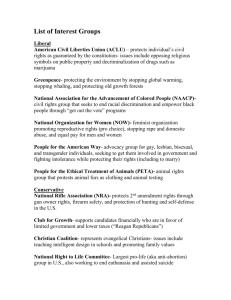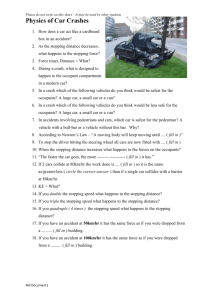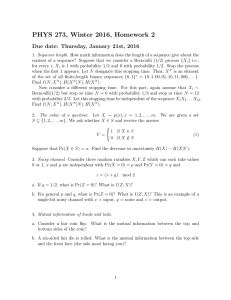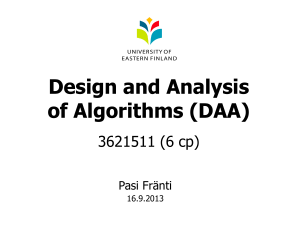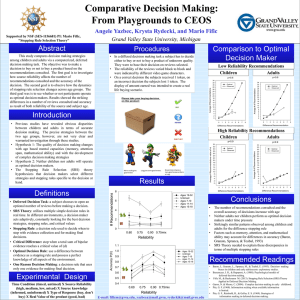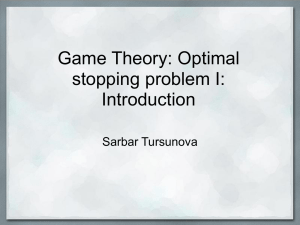Stopping Rule Selection (SRS) Theory Applied to Deferred Decision Making Mario Fifić
advertisement
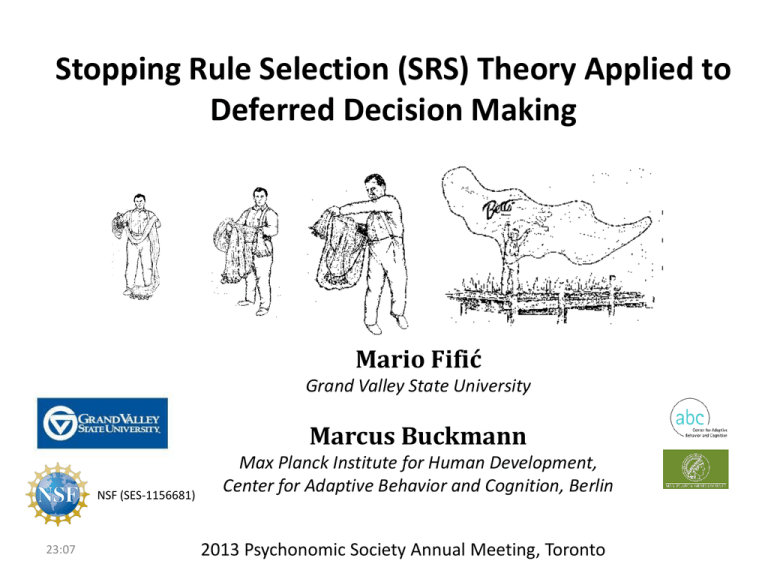
Stopping Rule Selection (SRS) Theory Applied to
Deferred Decision Making
Mario Fifić
Grand Valley State University
Marcus Buckmann
NSF (SES-1156681)
23:07
Max Planck Institute for Human Development,
Center for Adaptive Behavior and Cognition, Berlin
2013 Psychonomic Society Annual Meeting, Toronto
Research Group
Angele Yazbec
Tessa Johnson
23:07
Krysta Rydecki
Kylie Loudenslager
Jeremy Winget
Kyle Zimmer
Kelly Dillon
Andrew Humphrey
Phenomena
•
Decide whether to buy a certain product or not, based on an
optional number of reviews offered a service of web-online
shopping providers such as Amazon or Buy.com.
•
“ The Three Strikes and You-are-out” law(s) is advocated as punitive
and deterrence strategy for reducing violent crime. The law is
based on “three strikes” rule: if a newly convicted criminal had a
record of two prior felony convictions, which is considered as a
serious crime, the judge has to impose the maximum sentence for
the third crime.
•
How many doctor’s opinion?
•
Buridan’s anecdote a donkey cannot decide between two equally
attractive piles of hey, and starves to death
•
Memory retrieval task
0.004
0.003
Input
23:07
1
2
3
4
Decision
AND
gate
RT
0.002
0.001
200.
400.
600.
800.
1000. 1200. 1400.
Common denominator?
23:07
Common denominator is a
Stopping Rule
• Stopping Rule: a decision rule used to decide
when to stop with evidence collection and for
making final decisions.
0.004
Input
1
2
3
4
Decision
AND
gate
0.003
RT
0.002
0.001
23:07
200.
400.
600.
800.
1000. 1200. 1400.
Deferred decision making task
•
•
23:07
In a deferred decision making task, subjects must
decide whether or not to buy a product of
unknown quality, basing their decision on reviews
selected.
The reliability of the reviews varied
(for example .6, .75, .9).
Stopping rule in judgment and
decision making
• Optimal Rule belongs to Optimal Decision Maker:
• Stop when the expected value of loss is equal to, or lower than the expected
loss associated with deferring the decision and collecting more evidence.
• Requirements: calculate the so-called posterior odds in favor of the hypothesis that the
option 1 is beneficial given the evidence (opinions) acquired from n
Option 1
sources Ω (
| opinion). The posterior odds would indicate the best decision for
Option 2
the finite number of opinions, if the costs and payoffs associated with the risky decision
and the expected diagnostic value of a single opinion are considered.
• the exact statistical representation of the environment nor optimization is required
• Non-optimal Rules belong to Suboptimal Decision Maker:
• Critical Difference: stop when a total sum of bipolar evidence reaches a
critical value of (d).
• Fixed Sample Size: stop a collection on a certain number of evidence (s)
• Runs (Streak): stop on a repeated sequence of evidence of a certain size (r).
• Requirements: the exact statistical representation of the environment nor optimization
is not required
23:07
Are people optimal decision makers?
• (1) People bought too much or too little
evidence (recommendations) (Pitz, 1968)
Average # Recommendations
p=0.6
34
32
30
28
26
24
22
20
18
16
14
12
10
8
6
4
2
0
Optimal
Observed
0
23:07
1
2
3
4
5
6
7
Difference Recommendations
8
Are people optimal decision makers?
(2) People terminated evidence collection when the critical difference
was zero (d=0; Pitz et al., 1969)
{Buy, Buy, Don’t, Don’t}→Buy
{1, 1, 0, 0}→1
Average # Recommendations
p=0.6
34
32
30
28
26
24
22
20
18
16
14
12
10
8
6
4
2
0
Optimal
Observed
0
1
2
3
4
5
6
7
8
Difference Recommendations
(3) People stopped on nondiagnostic patterns of recommendations
{Buy, Buy, Buy, Don’t}→Buy
{1, 1, 1, 0}→1
(4) The principle evidence against: decision making in small worlds
23:07
Are people optimal decision makers?
People are not optimal decision makers.
Then people are suboptimal decision makers?
Heuristics
Bounded Rationality
Biased Decision Making
23:07
A catalogue of boundedly rational
stopping-rules
• Stopping rules:
– (a) Fixed Number
– (b) Critical Difference
– (c) Runs
– (d) Fixed forgetting model
– (e) Horse Race or Accumulator Model
– (f) Myopic Decision Rules.
• Although boundedly rational models have been able to explain some observed
deviations from the optimal predictions no single such rule has been able to
account for them all.
• The challenges:
– No single rule can be used to explaining the total variance of observed behavior.
– How to coordinate use of different stopping rules?
– How to act adaptively in different environments?
23:07
The Stopping Rule Selection (SRS)
Theory
• The SRS theory provides the basis for a
general approach to decision-making
operations. This theory is consistent with the
idea of a boundedly rational decision maker
who utilizes simple decision rules in real time.
In different environments, a decision maker
acts adaptively, constantly looking for the best
decision strategies, stopping rules, and critical
values.
23:07
A formal description of the SRS
theory and proposed stopping rules.
• Hypothesis 1: Multiple stopping rules.
• Hypothesis 2: Storage for stopping rules—the
decision operative space (DOS).
• dimensionality reduction
• Hypothesis 3: Retrieval of the stopping rules
23:07
Decision Operative Space (DOS)
Cognitive Effort
Critical difference stopping rule
Fixed size stopping rule
6
5
4
6
5
3
4
2
RUNS stopping rule
3
2
4
1
2
23:07
3
Time
Decision operative space
Cognitive Effort
23:07
Time
The double tradeoff
Depending on where stopping rules are retrieved from the DOS, a decision maker
may choose to trade off speed and accuracy (cf. Diederich, 2003; Kocher & Sutter,
2006; Payne et al., 1993) or cognitive effort and accuracy (Payne et al., 1993).
Decision operative space
Cognitive Effort
Cognitive Effort
Decision operative space
Critical difference stopping rule
Fixed-sample-size stopping rule
7
6
5
6
4
5
3
Runs stopping rule
4
2
Work harder
Critical difference stopping rule
Fixed-sample-size stopping rule
Take longer
Runs stopping rule
3
2
4
1
2
23:07
3
Time
Time
Validation: SRS model fit to Busemeyer and
Rapoport (1988) data
23:07
Buying decision
novel evidence
Timing conditions
Time pressure
Free-Evidence
23:07
Recommendation
Reliability
R2
0.6
0.73
0.75
0.79
0.9
0.91
0.6
0.46
0.75
0.57
0.9
0.81
Observed matched patterns
Evidence
{1.}
{0.}
{0.}
{1.}
{1.,1.}
{0.,0.}
{0.,0.}
{1.,1.,1.}
{0.,1.,1.}
{1.,0.,1.}
{0.,0.,0.}
{0.,1.,0.}
{1.,0.,1.}
{1.,0.,1.,1.}
{1.,1.,0.,1.}
{0.,1.,0.,0.}
{1.,0.,0.,0.}
{0.,0.,1.,0.}
Response
Correct
Inc
Correct
Inc
Correct
Inc
Correct
Correct
Correct
Correct
Correct
Correct
Inc
Correct
Correct
Correct
Correct
Correct
Observed Predicted
0.225
0.251
0.025
0.033
0.25
0.255
0.03125
0.0315
0.1375
0.129
0.00625
0.002
0.125
0.126
0.0375
0.0395
0.0125
0.005
0.00625
0.01
0.03125
0.0355
0.01875
0.015
0.00625
0.001
0.01875
0.007
0.00625
0.0015
0.00625
0.0075
0.00625
0.0065
0.00625
0.003
Conclusions
• The stopping rule selection theory (SRST ) theory is consistent with the
general idea of a boundedly rational decision-making agent utilizing
simple decision rules, in real time.
• SRST does not need a statistical description of the environment for
effective and adaptive decision making. In different environments, a
decision maker acts adaptively, constantly looking for the best decision
strategies, stopping rules, and critical values.
• The main innovation here is that for any given decision problem, a
decision maker is not limited to using a single decision strategy or stopping
rule but can draw from a large set of different kinds of and stopping
rules .
• The SRST theory has shown a good fit of the challenging data. For this
purpose we adapted pattern analysis—an innovative method for fitting
the relative frequency of observed data patterns to the predicted
response patterns.
•
The SRS model was able to account for the three paradoxes that falsified
the optimal decision making approach.
23:07
Benefits of SRST
•
•
•
•
•
•
Generality: The SRS theory is more general than any single-stopping-rule evidenceaccumulation model.
Parameter Space Reduction: The cast-net approach can reduce the number of free
parameters, despite the SRS theory being a general model.
Fast and Frugal: The SRS model requires minimal computational effort compared
to an optimal approach.
Corrective Feedback Is Not Needed: The way in which the SRS theory chooses the
stopping rules is determined solely by evaluation of the time and effort needed for
the situation.
Stopping Is Guaranteed: The mechanism of multiple stopping rules avoids the
Buridan’s donkey paradox. If the donkey had used a combination of the critical
difference and the fixed-sample-size stopping rule, chances of stopping earlier
would have increased, and the donkey would have been saved. Using multiple
stopping rules is a very useful strategy in real life.
Saving Decision Time Through Statistical Facilitation: If several stopping rules are
used, all of which can result in the same decision accuracy, overall decision time
will be faster than when only one stopping rule is used in isolation.
23:07
